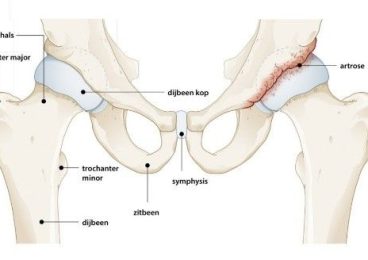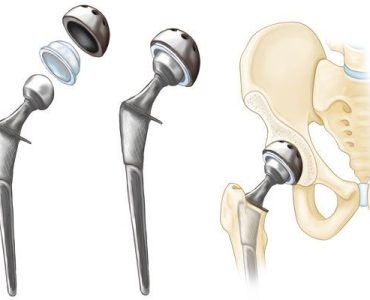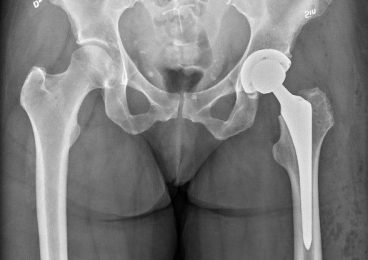Overview
You have been to the outpatient clinic with your orthopedic surgeon and as a result of your complaints and the abnormalities on the X-ray you have jointly decided to have an artificial hip placed to reduce your complaints. Such an operation is no small matter and the rehabilitation requires a lot of willpower and effort from you and from your immediate environment, such as family members and friends. Good preparation and good information will contribute to a speedy recovery. The rehabilitation process is intended to support you in this as well as possible. It is important that you are accompanied by someone who can visit you regularly, so that this person is also fully aware of the route to be followed.
Your orthopedic surgeon has already explained a few things to you at the outpatient clinic. In this information brochure you can read everything about your operation and the rehabilitation process. It also contains a video that shows you broadly what your operation entails.
The worn hip
The hip joint is a ‘ball joint’. When walking and moving, the bulbous head of the femur slides smoothly around in the socket of the pelvis. This is possible because there is a layer of cartilage on the head and in the socket. Cartilage is a smooth and resilient tissue. With age, the layer of cartilage thins and may even disappear. This is referred to as wear and tear or osteoarthritis. The worn joint can lead to pain and restriction of movement. If the complaints increase, this may be a reason to switch to the placement of an artificial hip. In this case, both the head and the bowl are replaced. This is also known as a total hip replacement (THP).
Causes of wear
There are several causes of osteoarthritis:
- The cartilage layer of the joint wears out for unknown reasons. This thins the layer of cartilage on the bone end. Eventually the bone is (partially) exposed. This type of osteoarthritis is most common in middle-aged or older people
- An inflammatory reaction of the joint can affect the cartilage, for example in rheumatoid arthritis (rheumatoid arthritis). This also makes the cartilage layer on the bone end thinner, or the layer disappears completely. This can occur at any age.
- After an infection of the joint (septic arthritis).
- Osteoarthritis can also develop after another condition, such as a bone fracture or a congenital hip defect. The cartilage can be damaged directly or wear out extra quickly due to a different way of moving. Osteoarthritis that occurs after a bone fracture or accident is called post-traumatic osteoarthritis. This can still occur many years after the accident.


Complaints
The most common complaint of hip wear and tear is pain. You usually feel pain in the groin, in the buttock or on the outside of the thigh. This sometimes extends to the thigh and knee. The hip is often stiffer and putting on socks or shoes, for example, is more difficult. Many people have pain when getting up from a chair (starting pain) or wake up at night because of the pain (night pain). People also often experience that the hip has to loosen up in the morning (morning stiffness). Walking, bending over and climbing the stairs are becoming increasingly difficult. The complaints increase as the wear and tear worsens.
Examination
The diagnosis can usually be made on an X-ray.
Treatment
In an early stage, a worn hip can often be treated with medication (painkillers / anti-inflammatory drugs) and it is advised to keep moving a lot. If necessary, a physiotherapist can provide support. It can also help to adjust the lifestyle by, for example, losing weight. If the hip gives so much pain and stiffness that walking is seriously difficult, a decision can be made to have a total hip prosthesis. Benefits of the operation The pain you had before surgery will often be greatly reduced. Sometimes the hip joint is still somewhat sensitive in the first few months, but after 1 year 90% of patients are satisfied with the result of the procedure. The stiffness of the hip also improves, but because the muscles around the hip are often shortened due to the long-standing pain, the hip often does not become as flexible as it once was.
Registration details
Since mid-2021 we have been affiliated with the Dutch National Register of Orthopedic Implants (LROI). With the help of this register, the quality of prostheses and orthopedic care can be monitored, compared and improved internationally. This registration makes it clear, for example, how long different hip and knee prostheses function properly. We will also use questionnaires to record your experiences and rehabilitation. The register helps the orthopedist to choose a well-performing hip or knee replacement. Your data is registered anonymously. See www.lroi.nl for more information about the register.
Before surgery
After you have decided with your orthopedist to have an artificial hip fitted, you will be given an appointment to visit the anesthetist for a preoperative screening. You must have blood drawn for this. The anesthetist will, among other things, discuss with you whether you will receive an epidural or general anesthesia during the operation. With an epidural, you may also be given a sedation so that you will have little or no pain from the operation. If you are being treated by, for example, a cardiologist or lung specialist, in some cases information will be requested from them. When the screening has been completed, the planning department will call you as soon as the date on which you can be operated is known.
Admission/date of surgery/stay
The scheduling and admissions department will call you about a date for your surgery. If you have a wound or infection just before your admission, please report this immediately. For the generally applicable information regarding admission and stay in the CMC, we refer to the general information. Usually, patients who come for a total hip replacement stay in the hospital between 2 and 5 days. In principle you can go home when the wound is dry and the exercises with the physiotherapist are going well.
The operation
During the operation, an incision is made in the skin, after which the hip is opened. The old femoral head is removed (see Photo 2 and 3 and film). The hip socket is then prepared with a milling cutter and a new metal or plastic bowl is placed. After this, a metal stem is placed in the upper leg, on which a metal head is placed. The new head and socket form the new hip joint. After placement of the prosthesis, the wound is closed with sutures and/or metal staples. After about 2 weeks, the stitches are removed at the orthopedic’s outpatient clinic. The operation normally takes 45-90 minutes. After the operation, you will receive shortterm antibiotics through the IV to minimize the risk of infections.
In Curaçao we only use prostheses that have shown good long-term results in international studies. The orthopedist can choose a prosthesis that is fixed with or without cement. Both options show good longterm results.
After the operation
After the operation you will go to the recovery room. Here, too, you remain connected to monitoring equipment, so that we can monitor your bodily functions. When you are fully awake and all bodily functions are in order, you will return to the nursing ward. The nurse of the ward will inform your contact person and he or she may then visit you in consultation with the nursing ward. After the operation you will have an IV in your arm. You will be given antibiotics and additional fluids via this route. You have an increased risk of developing thrombosis (blood clots in the blood vessels) in the period after the operation, partly due to reduced mobility. To prevent this, you will receive anticoagulant medication from your orthopedic surgeon for five weeks after the operation.
Post-treatment
After the operation you will start rehabilitating as soon as possible and a check-up picture will be taken. The physiotherapist will guide you with exercises in bed, with getting out of bed as quickly as possible and learning to walk. You will use a walker first and possibly crutches later. The physiotherapist will also teach you how best to stand, how to lie down, sit and sleep. You will leave the hospital on foot with an aid (walking frame or crutch) and you will be given certain rules of life.
Sometimes you will also receive a referral for a physiotherapist. The number of days you stay in the hospital depends on how your rehabilitation is going. About 2 weeks after surgery, you will return to your orthopedist for a check-up and the removal of stitches. Your hip is often a bit sensitive during the first months after the operation. These changes in feeling affect the way you walk. Your muscles need time to adapt to the new situation. If the wound shows signs of infection after returning home, such as an increase in redness or warmth, fluid leakage from the wound, much more pain or fever, please contact your treating orthopedist immediately.


Complications
Fortunately, complications with the placement of a total hip replacement are very rare, but now follow a number of common complications.
- Wound infections and infection of the hip prosthesis, around the recovery period or years after.
- Luxation. This means that the head of the artificial hip comes out of the socket. This is most likely in the first three months after surgery. You should therefore adhere to the movement instructions and pay close attention during the rehabilitation. If your hip does dislocate, you will be lifted up again and the head of the artificial hip will be placed back into the socket. This is done under sedation/anaesthesia.
- There may be a fracture of the socket or thigh during the operation. This can usually be solved easily during surgery.
- Calcifications around the hip joint.
- Bleeding.
- Leg length difference (you may then have to wear a heel in the shoe). A leg length difference is sometimes unavoidable to ensure that the hip prosthesis is stable. By making the leg a little bit longer, the stability of the joint increases and the chance of the hip popping out (luxating) decreases. The body gets used to a small leg length difference after 3-4 months after the operation.
- Thrombosis and pulmonary embolism (clots in the blood vessels of the legs, which then travel to the lungs). To minimize the risk of this, you will be given blood-thinning agents in the form of syringes or tablets for five weeks;
- Loosening of the prosthesis after a longer period of time. The hip prosthesis can then be replaced if necessary.
- Nerve damage (paralysis of part of the leg) can occur.
Frequently asked questions about a total hip replacement
- How long will my hip remain sore?
- How long will my leg stay swollen?
- How long should I keep taking the blood thinners?
- How do I care for my wound?
- When can I take a shower/bath again?
- When can I sleep on my side again?
- When can I garden again?
- When can I go back to work?
- What kind of shoes should I wear?
- Do I have to wear a compression stocking?
- What should I pay attention to after hip surgery?
The pain after having a hip prosthesis is gradually reduced. Three to four months after surgery, most people have (almost) no complaints. Improvements can still occur up to a year after placing the prothesis. Sometimes a dull ache is felt after long walks; this feeling can occur for up to about twelve months. Starting pain (pain with the first few steps after getting up) may persist for a while. This painful sensation improves without treatment. It does not mean that the prosthesis is not functioning properly or is loose!
The swelling usually decreases during the first weeks after discharge. The weight gain will be reduced by elevating the legs regularly during the day. The swelling is generally the worst in the evening and decreases if you continue to do the exercises well.
After the operation you should take an injection or tablet once a day against the thrombosis. You should do this for at least five weeks after the operation (if necessary, this will be decided by the general practitioner or specialist). If you are already taking blood thinners before surgery, your doctor will advise you on their use.
The wound should remain clean and dry. The skin around the sutures or staples may look red or irritated. When the stitches or staples are removed (after about two weeks) this redness will gradually decrease. If the wound area becomes swollen, red or has fluid leaking out, it is wise to contact your orthopedic surgeon.
You may take a shower when the wound is well covered with a plastic bandage. Three days after the stitches are removed, you can take a bath or shower without a plastic bandage. Do not immediately take a bath or in the sea for an hour and do not let the wound soften. It is better to wash the wound with your hands and not with a washcloth for the first two months. Also be careful not to use cream or lotion around the wound area.
Consult with your orthopedic surgeon, during the outpatient check after 6 weeks, whether and on which side you can sleep.
If you want to garden, you can discuss this with the doctor during the first outpatient visit. The advice of the physiotherapy is to use a sitting / kneeling bench and a hoe with a long handle.
Most people are back to work after approximately 2-6 months, depending on the type of work and the progress of recovery and the advice of the orthopedic surgeon and/or physiotherapist. Light physical work can possibly be resumed earlier.
It is wise to wear shoes that are tight to the foot and have a wide heel. High heels and flip flops should be avoided for the first three months.
It is not really necessary to wear a compression stocking, but it does help reduce the swelling in the leg. If your leg swells up during the day, it is therefore wise to wear one.
During the first three months after the operation, it is very important that you observe the following rules
of life to prevent luxation (dislocation of the hip joint).
1. Do not bring your knee towards your nose (for example, to cut your nails).
2. Do not bend over from a chair.
3. Do not sit cross-legged.
4. Don’t squat.
5. Do not sit on a low chair or stool.
6. Do not bend over from a stand with legs together. You will be taught how to pick something up off the floor with the operated leg extended backwards.
7. Do not put on the stocking and shoe (laces) of the operated leg in the “normal way”.
8. Avoid extreme movements.
9. During this time, the legs should be kept slightly apart when sitting and lying down.
10. You can and may stand alone, but make sure that you do not walk and/or make a turning movement. Standing, for example at a counter, is therefore possible and allowed.
11. Gymnastics and (limited) sports are possible and allowed aft
Hip replacement movie showcase (with permission from the Dutch Orthopedic Association)


